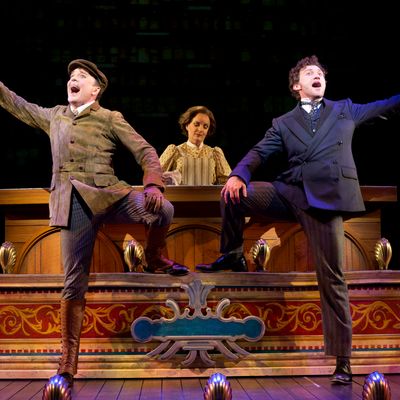
Even aside from the problem of an ever-shrinking chorus, there’s a reason musicals about multiple murders, unlike dramas and movies and television shows, are so uncommon. In a musical, the stakes have to be high enough to give the characters a reason to sing. Yet if the stakes are high enough for serial killing, all but the greatest songs can seem ludicrous. (I’m talking to you, Jekyll and Hyde.) So unless you’re the man who wrote Sweeney Todd, you probably want to go with satire, as Rupert Holmes did in adapting Dickens’s The Mystery of Edwin Drood. Following in Drood’s slightly mincing footsteps, the authors of the new musical A Gentleman’s Guide to Love and Murder aim for droll comedy; especially in the knock-’em-dead performance of Jefferson Mays as various undearly departeds, they usually hit their mark.
That’s partly due to the clever source material: a 1907 novel called Israel Rank: The Autobiography of a Criminal and the 1949 Ealing comedy, Kind Hearts and Coronets, that’s loosely based on it. From the former comes the story of a young man who, having been disinherited by a wealthy family, sets out to kill each of the heirs standing between him and his rightful position. From the latter comes the concept of having all of those heirs — young and old, male and female — played by one actor, in the movie’s case Alec Guinness. All versions are told in flashback as the killer awaits his fate in prison, and all three are comedies, though of a progressively lighter stripe.
But for all the musical’s debts to those sources, its authors (Robert L. Freedman and Steven Lutvak) and director (Darko Tresnjak), making their Broadway debuts, seem to have taken as much inspiration from Drood. Like that 1985 show, Gentleman’s Guide provides tonal cover with a music-hall milieu that includes a stage within a stage, scalloped footlights, and a Dollyesque passerelle. The setting is Edwardian rather than Victorian, but distant enough from our own age to make the killings quaint. (The characters’ nationality also forgives a multitude of sins; did the English do nothing at the turn of the last century but murder one another?) There are watered-silk smoking jackets and period-style songs and plenty of winks to the audience. Also like Drood, in which audience members are asked to select the evening’s true villains by vote, Gentleman’s Guide has a fail-safe meta-theatrical gimmick.
That gimmick, which is to say Jefferson Mays, ends up wagging the dog. Nominally, the protagonist is young Montague D’Ysquith Navarro, whose mother was the one originally disowned by the noble family, after marrying “a Castilian.” (In the novel, she married a Jew; in the movie, an Italian.) It’s Monty (Bryce Pinkham) who narrates the story of the untimely deaths of the eight D’Ysquiths who stand between him and Highhurst castle. Pinkham has the requisite charm (and appealing voice) to keep the audience on his side despite his deeds, and to keep his two love interests (Lisa O’Hare as a vain gold-digger and Lauren Worsham as an unconventional heiress, both perfect) convincingly enamored as well.
But it’s Mays as the doomed D’Ysquiths who dominates. In act one we meet all eight, of whom seven quickly proceed to their death. (The story is cleverly structured to avoid diminishing returns by devoting the whole of act two to the last lord standing.) Each D’Ysquith faces distinct and comically awful demises, by such methods as bees and barbells and holes in the ice. (I shouldn’t say more about the modes of death except to note that the family name is pronounced DIE-squith, which pretty much sums it up.) And while anyone might get laughs being poisoned, the trickier task that Mays faces, and pulls off brilliantly, is creating, sometimes in just a moment of stage time, distinct and comically awful characters. They have to be distinct immediately, or the audience wouldn’t be able to keep track. And they have to be awful, or the audience would not be so glad to have them go. In response to the challenge, Mays produces, seemingly at will, a parade of twits, an almanac of tics, a thesaurus of boorishness. You may think he can’t top the Reverend Lord Ezekial D’Ysquith, with his buckteeth, muttonchops, and possibly defective genetic makeup, but he does. And does. And does.
Mays is aided, no doubt, by terrific costuming (Linda Cho) and wig design (Charles LaPointe); the whole production looks terrific and moves smoothly from start to finish. It’s probably downright unsporting to say that in one small area, though, the musical disappoints. That would be the songs. The tunes (by Lutvak) are lovely, and will no doubt bear up to repeated listening. The words (by Lutvak and Freedman) are often clever enough to raise a laugh — not easy in the midst of rushing melody. Lady Hyacinth D’Ysquith, a predatory do-gooder, is neatly satirized in a Gilbert-and-Sullivan stanza:
We’ll civilize a village in the jungle!
It can’t take long to learn their mother tongue!
Of words they have but six,
And five of them are clicks,
And all of them are different words for dung!
In another song, Lord Adalbert D’Ysquith gets characterized in a verse straight out of Ruddigore:
I don’t understand the poor.
And they’re constantly turning out more.
Every festering slum
In Christendom
Is disgorging its young by the score.
Perhaps it made sense to limit the musical palette to charming tea dances and to rely so heavily on operetta approaches to the lyrics. (There are even answering choruses: “To summarize the heretofore, / He does not understand the poor.”) But what this material needed from its songs, and does not get, is exactly what Mays brought to his task: a strong, clear, distinctive profile. Without it, for all its merits, the show never quite achieves musical liftoff. You want the score to raise the dead, not just bury them.
A Gentleman’s Guide to Love and Murder is at the Walter Kerr Theatre.

